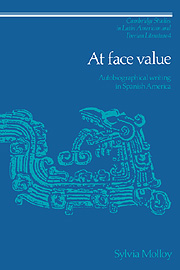Book contents
- Frontmatter
- Contents
- Acknowledgments
- Introduction
- PART I THE SCENE OF READING
- 1 The reader with the book in his hand
- 2 From serf to self: the autobiography of Juan Francisco Manzano
- 3 The theatrics of reading: body and book in Victoria Ocampo
- PART II CHILDHOOD AND FAMILY TALES
- PART III MEMORY, LINEAGE AND REPRESENTATION
- Notes
- Bibliography
- Index
1 - The reader with the book in his hand
Published online by Cambridge University Press: 14 September 2009
- Frontmatter
- Contents
- Acknowledgments
- Introduction
- PART I THE SCENE OF READING
- 1 The reader with the book in his hand
- 2 From serf to self: the autobiography of Juan Francisco Manzano
- 3 The theatrics of reading: body and book in Victoria Ocampo
- PART II CHILDHOOD AND FAMILY TALES
- PART III MEMORY, LINEAGE AND REPRESENTATION
- Notes
- Bibliography
- Index
Summary
Not surprisingly, Borges provides us with a beginning. In one of his later stories (those his critics hailed, with short-sighted relief, as “at last realistic”), a young, likeable city-dweller of conventional culture finds himself stranded in a desolate country estate. His sole companions are the foreman, his son and his daughter – illiterate, barely articulate descendants of Scottish settlers who had inter-married with Indians. All conversation with the three having proved impossible, the young man, in order to establish some contact, takes to reading to them from an old English Bible he has found in the house. The blank pages at the end record the spotty lineage and history of the family, from the time they set forth from Inverness up to the moment when they lost their capacity to write. Spurred on by vague didactic notions, the young man actually does more than read to them: choosing the Gospel according to St Mark, he practices reading “as an exercise in translation, and maybe to find out whether the Gutres understood any of it.” The Gutres (or Guthries, as they were named originally) turn out to be the most attentive of listeners; in perfect silence they absorb every word that is read to them and when the Gospel is over demand that it be read (translated) to them again “so that they could understand it better.”
- Type
- Chapter
- Information
- At Face ValueAutobiographical Writing in Spanish America, pp. 15 - 35Publisher: Cambridge University PressPrint publication year: 1991

